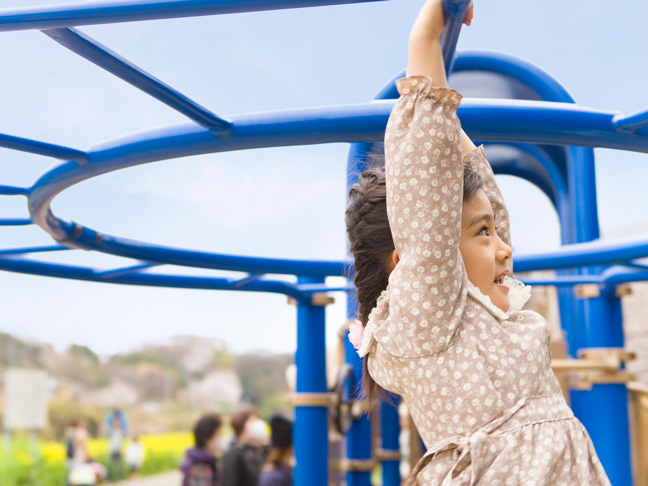“Oh the insanity,” I sometimes think in my head with three rambunctious boys running around my little apartment. My 16-month-old thinks that he can do whatever his big brothers do (of course!), so injury prevention is high on my list of priorities. Accidental injuries are the leading cause of hospitalization and death in young children. There are some estimates that suggest every four seconds a child is treated in the emergency room for an injury. Many of these injuries are preventable. With many things, but especially with injuries, an ounce of prevention is worth a pound of cure. Below are some common toddler injuries I see as a pediatrician and some steps on how to prevent them.
1. Falls
One of the most common frantic calls I get is about a toddler who fell off a bed, a piece of playground equipment, a chair, or another high object. I always tell patients that littles are untrustworthy and should never be left alone on a high surface. Other important parts of fall prevention include: making sure the crib is at the lowest level, removing any objects children can use to climb out of the crib, always strapping a child into a high chair or car seat, and using safety prevention measures around the home such a stair guards and window guards.
2. Choking
While you may not be able to get your little kids to put veggies in their mouths, they will often happily find the one speck of dust on the floor and pick it up. Toddlers can pick up small pieces and do have a propensity to explore the world through their mouths. Keep all small objects up high and out of reach. If you live a small apartment like I do, your changing table may be near the crib; be careful about what you leave out on the changing table that little ones may pull into the crib once you leave the room. This includes both choking risks and things that might be poisonous if ingested. In addition, it is important to avoid foods that are common choking hazards such as nuts, candy, popcorn, whole grapes, hot dogs, and raw carrots.
3. Strangulation
Toddlers love to explore and experiment and lack the cognitive ability to understand things that can lead to a dangerous situation. Avoid having window blinds with cords. Remove all mobiles from above the crib by 4 months of age. Make sure all cords are hidden and out of reach.
4. Drowning
Accidental death from drowning is the leading cause of unintentional injury in children ages one to four years old. Parental vigilance when children are near water is essential. Be vigilant around all types of water. In children under age 1, drowning occurs most commonly in bathtubs, buckets, and toilets. Never leave your child unattended around any water. Drowning can occur in small amounts of water and very quickly. Always know where your child is. Never leave your child unattended in or near water, even if a lifeguard is present. Instruct babysitters and caregivers about potential water hazards and the importance of water safety. If you are in the water with an infant or a toddler, always be within arm’s length of your child and touching them, providing what is referred to as “touching safety.”
5. Poisoning
Young children explore with their mouths and common household items, and certain medications may look like juice or candy to a toddler. Keep all medications high and out of reach. When visiting relatives, make sure that medications are put away and out of reach as well. Keep all cleaning agents locked up and in their original bottles. Follow the recommended dosing for your child’s weight and the interval frequency of all over the counter medications. If you are not sure of your child’s dose, check with your child’s pediatrician. At every well visit, ask the pediatrician what the correct dosings of common medications are, and keep that information posted somewhere accessible. In addition, keep the number for poison control posted.
6. Burns
It only takes a few seconds for a curious toddler to reach up and grab a hot mug of coffee. Never leave hot liquids within a child’s reach, and never carry a child and a cup of hot liquid at the same time. When heating bottles or baby food, never use a microwave as it can lead to uneven heating and burns. Keep the thermostat for your hot water heater set to less than 120 degrees to prevent accidental burns in the bath.
7. Car seat fails
Unfortunately, motor vehicle accidents are common. While as parents we can’t control other drivers, we can create the safest car environment possible for our children. Never ride in a car with your child without a car seat. Not only is having your child in an age appropriate car seat important, but making sure it is properly installed can truly save lives. Follow the recommended guidelines for car seat safety.
8. Hot cars
Children of any age should never be left alone in a car. It may feel like it’s only a split second, but it is not worth the risk to leave your little one alone. When baking in the sun, cars quickly heat up and are extremely dangerous. Always keep your car doors locked when parked in your driveway or in the garage to prevent children from accidentally sneaking in.
Even the most careful and cautious parent cannot prevent every injury. It may feel like injury prevention is an ever evolving process, and that’s because it is. As children develop various skills, certain risks diminish while others go up. Parenting is an amazing and sometimes scary task. The key thing to remember is that many injuries can be prevented. I highly recommend using preventative child-proofing measures and taking an infant and child CPR course to be prepared in emergency situations.
Photo: Getty/Michael H/Taxi Japan








